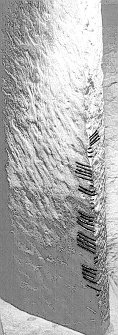Location and history:
According to Macalister, CIIC I, 108, "Windele, and following him Brash, state that this monument formed part of a `stone circle' gradually removed by the local peasants for building purposes." It "was appropriated as a lintel for a pig-stye, where it was discovered by Croker and Abell: removed in 1835 to the Royal Cork Institution, it is now in University College, Cork". The stone was first published (as a draft) by Oldham, PRIA 2, 1844, 517 ( fig. 4.), but without any attempt of a reading.
fig. 4.), but without any attempt of a reading.
The stone is marked as no. 23 in the U.C., Cork. As against the drawing printed in CIIC 1, 108, the stone was erected upside-down here.
Size according to Macalister, CIIC: 6'1" x 0'10 1/2" x 0'3 1/2"
- Published illustrations:
- Oldham, PRIA 2, 1844, 517,
 fig. 4 (draft of the stone plus sketch of the inscription);
fig. 4 (draft of the stone plus sketch of the inscription);- Brash, OIM
 pl. IV fig. 2 (draft)
pl. IV fig. 2 (draft)- Macalister, CIIC 1, 108 (draft).
- Brash, OIM
"Older" reading (by O'Donovan and O'Curry, quoted by Brash, JRSAI 10, 1869, 169):
AMCOC CUGAQUS
Reading Brash, JRSAI 10, 1869, 170:
CUNAGUSSOSUMA
"Corrected" reading Brash, JRSAI 10, 1869, 438:
Reading Macalister, CIIC I, 109:
CUNAGUSSOS MA[...
Interpretation Korolev, DP, 71:
CUNAGUSSOS MAQ[I ...
Reading McManus, Guide 65:
CUNAGUSSOS MA...
Reading Gippert (1981):
 "Sinister" angle, down:
"Sinister" angle, down:CUNAGUSSOS MA[
ᚉᚒᚅᚐᚌᚒᚄᚄᚑᚄᚋᚐ[
ᚆᚆᚆᚆᚐᚐᚐᚁᚁᚁᚁᚁᚐᚋᚋᚐᚐᚐᚁᚁᚁᚁᚁᚁᚁᚁᚐᚐᚁᚁᚁᚁᚋᚐ[
- JRSAI, 2.ser., 5, p. 336: W. Williams.
- Archaeological Journal 9, 1852, 116 (E. Hoare)